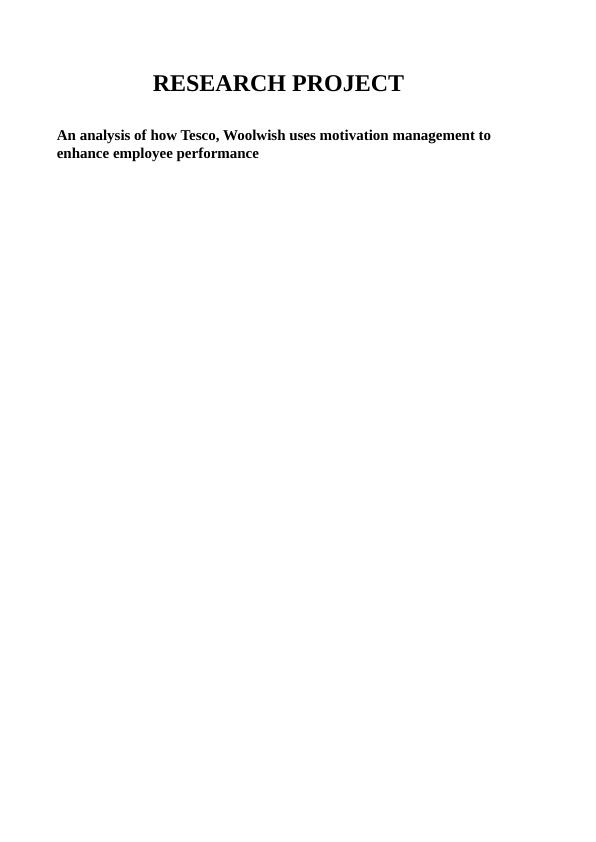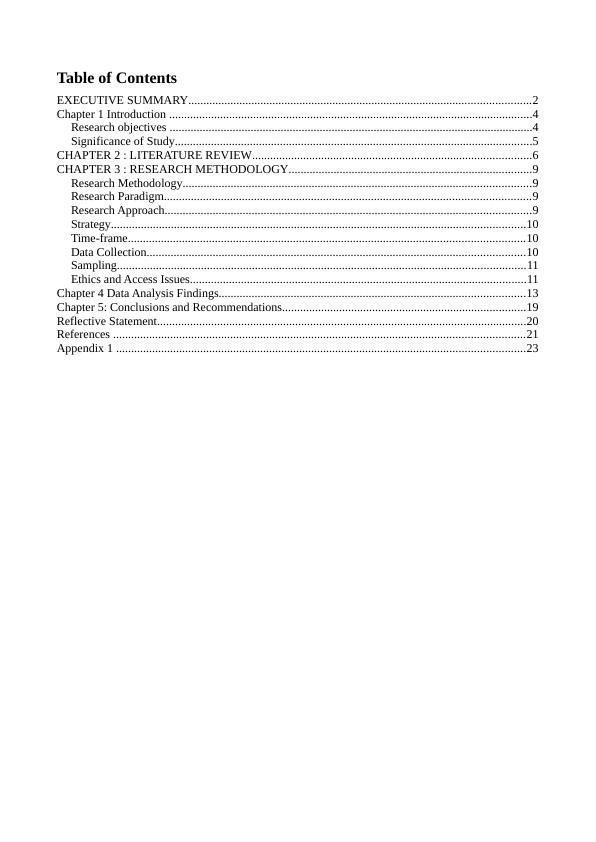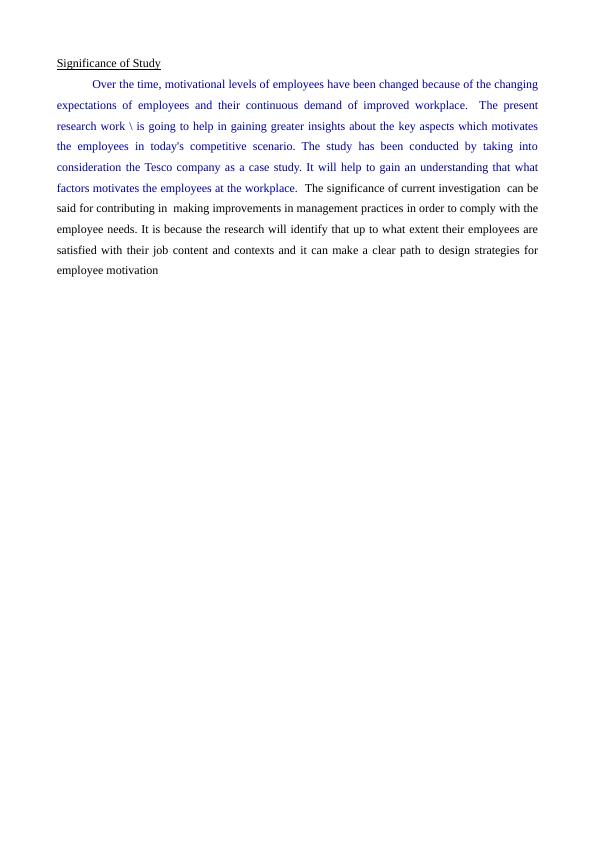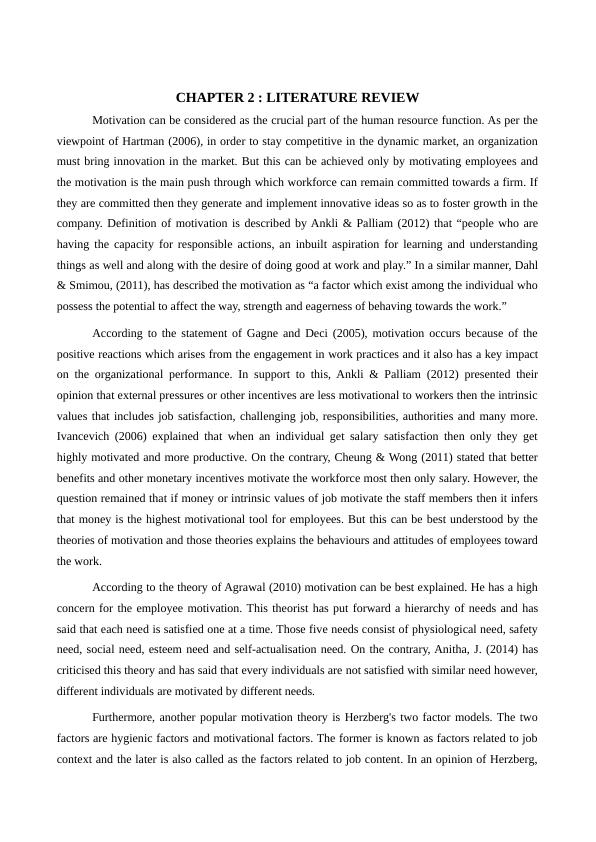Ask a question from expert
Management and leadership of Tesco Assignment
25 Pages7317 Words300 Views
Added on 2019-12-04
About This Document
This report is on the "relationship between motivation and employee performance". This report is going to analyze how Tesco, Woolwich uses motivation management to enhance employee performance. The objective of the study is to assess the relationship between motivation and employee performance. The report measures the motivation management practices which are carried out in Tesco organization. Primary and secondary information is collected for the present investigation. For a better understanding of the report, you can also check the case study on Tesco.
Management and leadership of Tesco Assignment
Added on 2019-12-04
BookmarkShareRelated Documents
RESEARCH PROJECTAn analysis of how Tesco, Woolwish uses motivation management to enhance employee performance

EXECUTIVE SUMMARYThe success of any organization depends on performance of the staff members and the levelof motivation. From a long run, high level of significance is witnessed in motivation and employeeperformance. This report is going to analyse how Tesco, Woolwish uses motivation management toenhance employee performance. The objective of study is to assess the relationship betweenmotivation and employee performance. The report measures the motivation management practiceswhich are carried out in Tesco organization. Primary and secondary information is collected for thepresent investigation. For gathering primary information questionnaire method is used in whichemployees of Tesco, Woolwish are asked to fill responses. For secondary information, varioussources have used such as books, journals, business reports, online articles and so on. From thereport, it was found to be highly committed to motivate the workers. The company motivatespeople through the non-monetary incentives.

Table of ContentsEXECUTIVE SUMMARY..................................................................................................................2Chapter 1 Introduction .........................................................................................................................4Research objectives .........................................................................................................................4Significance of Study.......................................................................................................................5CHAPTER 2 : LITERATURE REVIEW.............................................................................................6CHAPTER 3 : RESEARCH METHODOLOGY.................................................................................9Research Methodology....................................................................................................................9Research Paradigm..........................................................................................................................9Research Approach..........................................................................................................................9Strategy..........................................................................................................................................10Time-frame....................................................................................................................................10Data Collection..............................................................................................................................10Sampling........................................................................................................................................11Ethics and Access Issues................................................................................................................11Chapter 4 Data Analysis Findings......................................................................................................13Chapter 5: Conclusions and Recommendations.................................................................................19Reflective Statement...........................................................................................................................20References .........................................................................................................................................21Appendix 1 ........................................................................................................................................23

CHAPTER 1 INTRODUCTION Motivation is considered as an outstanding approach whose main motive is to generateenthusiasm within the organization to accomplish desired goals and objectives of the company.Further, high level of significance is present in order to keep customers of the enterprise happy bykeeping all the staff members satisfied. This allows business in enhancing overall productivityalong with the performance. Apart from this, it is well known fact that success of every organizationdepends on performance of the staff members and this in turn allows in gaining competitiveadvantage (Beardwell and Claydon, 2007).With the help of current study, an analysis has been made to study how Tesco, Woolwichworks to raise and develop employee morale. Further, the emphasis has been laid over assessing thedifferent motivational practices which play an effective role in gaining the employee performanceand organizational productivity. The UK has giant retail industries with ample of firms who arecompetitively working in order to strengthen their customer’s base (Overview of the retail sector inthe UK. 2016). For this, one of the largest company that is Tesco focuses highly on employees. Thisis the reason that tends this retail firm to gain large market share in the competitive businessenvironment. The growth prospectus has been evidenced from the consistently rising growth rateswhich contribute to be as major factors. In respect to above stated aspect, it has been found that optimum utilization of workingpractices of staff members, their potential enhancement through motivational theories and rewardpractices and efforts for employee retention are some key aspects which are highly considered intoaccount by the Tesco. These factors and efforts add competitive advantage to the working of thecited firm. Along with this, Tesco keeps activities which are associated with the overall employeeperformance, their work commitment, dedication and efforts in the successful working of thecompany in the entire retail sector of the UK. Research objectives The objectives of this research study are described as follows:1.To determine if there is a positive relationship between motivation and employeeperformance.2.To measure the motivation management practices which are carried out in Tescoorganization. 3.To determine which motivational techniques or factors motivate the work force most or leastat Tesco company.4.To analyze whether employees of this company are satisfied with their workingenvironments or not.

Significance of StudyOver the time, motivational levels of employees have been changed because of the changingexpectations of employees and their continuous demand of improved workplace. The presentresearch work \ is going to help in gaining greater insights about the key aspects which motivatesthe employees in today's competitive scenario. The study has been conducted by taking intoconsideration the Tesco company as a case study. It will help to gain an understanding that whatfactors motivates the employees at the workplace. The significance of current investigation can besaid for contributing in making improvements in management practices in order to comply with theemployee needs. It is because the research will identify that up to what extent their employees aresatisfied with their job content and contexts and it can make a clear path to design strategies foremployee motivation

CHAPTER 2 : LITERATURE REVIEWMotivation can be considered as the crucial part of the human resource function. As per theviewpoint of Hartman (2006), in order to stay competitive in the dynamic market, an organizationmust bring innovation in the market. But this can be achieved only by motivating employees andthe motivation is the main push through which workforce can remain committed towards a firm. Ifthey are committed then they generate and implement innovative ideas so as to foster growth in thecompany. Definition of motivation is described by Ankli & Palliam (2012) that “people who arehaving the capacity for responsible actions, an inbuilt aspiration for learning and understandingthings as well and along with the desire of doing good at work and play.” In a similar manner, Dahl& Smimou, (2011), has described the motivation as “a factor which exist among the individual whopossess the potential to affect the way, strength and eagerness of behaving towards the work.”According to the statement of Gagne and Deci (2005), motivation occurs because of thepositive reactions which arises from the engagement in work practices and it also has a key impacton the organizational performance. In support to this, Ankli & Palliam (2012) presented theiropinion that external pressures or other incentives are less motivational to workers then the intrinsicvalues that includes job satisfaction, challenging job, responsibilities, authorities and many more.Ivancevich (2006) explained that when an individual get salary satisfaction then only they gethighly motivated and more productive. On the contrary, Cheung & Wong (2011) stated that betterbenefits and other monetary incentives motivate the workforce most then only salary. However, thequestion remained that if money or intrinsic values of job motivate the staff members then it infersthat money is the highest motivational tool for employees. But this can be best understood by thetheories of motivation and those theories explains the behaviours and attitudes of employees towardthe work. According to the theory of Agrawal (2010) motivation can be best explained. He has a highconcern for the employee motivation. This theorist has put forward a hierarchy of needs and hassaid that each need is satisfied one at a time. Those five needs consist of physiological need, safetyneed, social need, esteem need and self-actualisation need. On the contrary, Anitha, J. (2014) hascriticised this theory and has said that every individuals are not satisfied with similar need however,different individuals are motivated by different needs. Furthermore, another popular motivation theory is Herzberg's two factor models. The twofactors are hygienic factors and motivational factors. The former is known as factors related to jobcontext and the later is also called as the factors related to job content. In an opinion of Herzberg,

End of preview
Want to access all the pages? Upload your documents or become a member.
Related Documents
Factors Affecting Employee Motivation EXECUTIVE SUMMARY: An Investigation on Factors Affecting Employee Motivationlg...
|44
|12335
|385
Effect of Employee Motivation on Organizational Performancelg...
|49
|13381
|268
The Impact of Motivation on Employee Performance - Tescolg...
|24
|5359
|388
Employee Development: Role of Line Managers and Leaders in TESCOlg...
|30
|8305
|291
The Role of Training in Business Performance: A Case Study of Tescolg...
|32
|10020
|20
Job Satisfaction in Multinational Enterpriseslg...
|40
|13036
|50